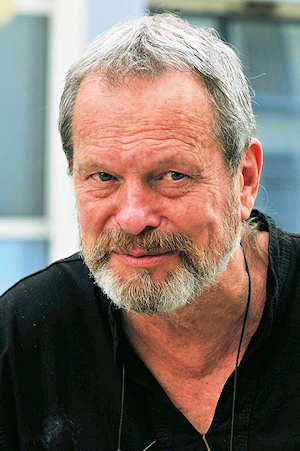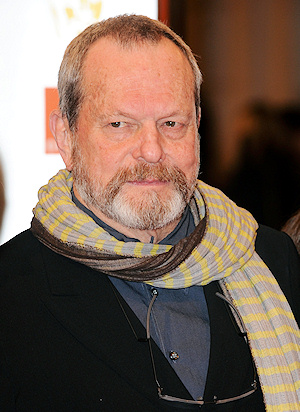|
This year's festival will feature a new event: a pre-inaugural tribute to Terry Gilliam will take place on November 10th. Cinema Italian Style will dedicate an evening to Mr. Gilliam with a public meet-and-greet after a screening of his most visionary film Brazil (1985) and a Los Angeles preview of The Wholly Family, filmed in Naples (produced by Garofalo) and starring Cristiana Capotondi, among others. During the Inaugural Evening, Mr. Gilliam will personally receive the Cinema Italian Style BVLGARI Award, a prize awarded every year to a person who has promoted exchange between the Italian film industry and the international film industry (the prize has previously been awarded to: George Clooney, Penelope Cruz, Vittorio Storaro, Milena Canonero, John Turturro, Douglas Kirkland).
"For most of Terry Gilliam's early career, fans of the popular comedy show Monty Python's Flying Circus assumed that he was British, since Python's other five members were natives of Britain. But the innovative animator and future director, who spent more time behind the scenes than in front of the camera, was actually the troupe's only American member. Born in Minneapolis, Minnesota, on November 22, 1940, Gilliam was briefly employed by Mad Magazine as a writer/illustrator before he emigrated to England in 1967. Soon after he arrived in the U.K., he began working on Do Not Adjust Your Set, a popular children's TV show, developing his eccentric animated cartoons, which put into motion a hodgepodge of images, including photographs, cutouts from magazines, and famous works of art. Gilliam's contributions to the show were geared more toward adults, as his surrealistic stream-of-consciousness segments, drenched in black humor, were beyond the grasp of most children.
In 1969, Gilliam was asked to join the absurdist comedy troupe Monty Python. In addition to writing for Monty Python's Flying Circus, Gilliam also contributed his animated interludes, for which he was pretty much left to his own devices; the other Pythons just told him how much time he needed to fill and never gave him any narrative direction. Gilliam began offering his iconoclastic vision to moviegoers with the comedy troupe's first original film, Monty Python and the Holy Grail (1975), which he co-directed with fellow Python Terry Jones. An instant cult classic, the movie contained all the requisite Python elements: absurdist humor, self-referential parody, and extremely quotable dialogue. The following year, Gilliam had his first outing as a solo director with Jabberwocky (1976). Based on the poem by Lewis Carroll, the film featured a medieval setting similar to that of Holy Grail and starred Pythonite Michael Palin. Along with Python's brand of irreverent humor, the film featured glimmers of the visual resplendence that would become the director's trademark. But critics found it awkward and repetitive, and audiences largely stayed away.
Following Jabberwocky's relative failure, Gilliam regrouped with his fellow Pythonites, co-creating The Life of Brian, the tale of a man with the misfortune of being confused with Jesus Christ. He left the directing duties to Terry Jones, focusing on animation, screenwriting, and acting. Gilliam returned to directing with Time Bandits (1979), a surreal journey through history led by a small boy and several dwarves. Bearing many similarities to Jabberwocky, Time Bandits relied less on repetition and moved the audience more briskly from one scene to the next. It did well at the box office and put Gilliam in the ranks of directors to watch.
After co-directing with Terry Jones the third and final Python film, Monty Python's the Meaning of Life (1983), Gilliam made what many people consider his masterpiece, the dystopian satire Brazil (1985). Instead of journeying back to the Middle Ages, Gilliam boldly predicted a retro-1930s future of anonymous office drones commanded by an all-powerful computer. Blindingly imaginative, the film starred Jonathan Pryce as Sam Lowery, who attempts to escape the stifling bureaucratic system by fantasizing about being a superhero, and later by actually battling the powers-that-be in his own cowardly fashion. Consistently blurring the line between fantasy and reality and uncompromising in its surreal eccentricity, Gilliam's masterwork has been called Orwellian, Kafkaesque, and Luddite. A failure at the box office, Brazil has made up for that disappointment with its cult status. In addition to critical praise and a Los Angeles Film Critics award for Best Film, Gilliam received an Oscar nomination for Best Original Screenplay.
|

|

|
It was four years before Gilliam stepped behind the camera again, for The Adventures of Baron Munchausen (1989). Returning to historical fantasy, Gilliam tells the unlikely tales of the title character as though they really happened. The Baron explores the inside of a volcano, takes a hot air balloon to the moon, gets swallowed by a whale, and quells a war that he himself started. Munchausen's stories were less well known to most Americans than to audiences in Britain, where the film won British Academy Awards for Best Production Design, Best Makeup, and Best Costume Design.
Gilliam followed Munchausen with his most accessible work to date, 1991's The Fisher King. Foregoing much of his usual ornate visual style, the director focused on characters rather than flashy spectacle; the relationships among a depressed former DJ (Jeff Bridges), his enabling girlfriend (Mercedes Ruehl, in an Oscar-winning performance), and a homeless man (Robin Williams) who saves him from suicide are intertwined in a riveting, funny, and ultimately heart-warming way. Gilliam balances humor, pathos, and story-telling, while avoiding mawkishness. He received a Golden Globe nomination for Best Director, and the movie won the Silver Lion Award at the Venice Film Festival.
Gilliam returned to the director's chair in 1995, achieving his biggest box office hit with the science fiction epic 12 Monkeys. Starring Bruce Willis, Madeleine Stowe, and Brad Pitt (in an Oscar-nominated performance), the movie tells the story of a prisoner from the future sent back in time to save the world from a catastrophic virus. But the scientists of 2035 haven't quite mastered the art of time travel, and they accidentally send Bruce Willis' character back to 1990 instead of 1996. The film was a critical and commercial success despite its hard-to-follow plot, allowing Gilliam the freedom to take even more creative risks. His next project, Fear and Loathing in Las Vegas (1998), an adaptation of Hunter S. Thompson's 1971 novel, was the ultimate "trip" movie. Detailing Thompson's drug-addled journey to the gambling capital of the world, it starred Johnny Depp as the author's alter ego, Raoul Duke. The movie was the perfect vehicle for Gilliam to create an alternate universe fueled by the mind-bending substances in which the lead characters freely and plentifully indulge. With melting faces, a lounge full of human-sized lizards, bats flying in the desert, and a demon with breasts on its back, the movie didn't need and didn't really have a plot. Fear and Loathing in Las Vegas was the definition of a love-it-or-hate-it movie. In 2000, the director began working on Good Omens, a comedy/fantasy based on the book Good Omens: or, The Nice and Accurate Prophecies of Agnes Nutter, Witch by Neil Gaiman and Terry Pratchett, a humorous story about the apocalypse. Though this endeavour would ultimately fall by the wayside, it proved nothing in comparison to the devastating blows that would be dealt to the director upon attempting to film his lifelong dream project, The Man Who Killed Don Quixote. With the production ultimately transforming into the very definition of Murphy's Law, the ill fated endeavor ultimately died a slow and painful death before given new, unexpected life in the surprise hit /documentary Lost in La Mancha. A comic tale of cinematic defeat, Lost in La Mancha chronicled the morose fate of The Man Who Killed Don Quixote in all of it's painfull and, at times, hilariously unbelieveable glory. Though Gilliam subsequently fought to buy back the rights to the film in order to take a second shot at his dream, it remained to be seen whether The Man Who Killed Don Quixote would ever see the light of day."
Eric Bloch, All Movie Guide
|
|